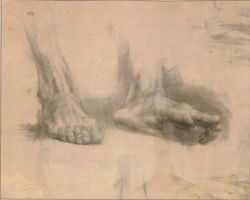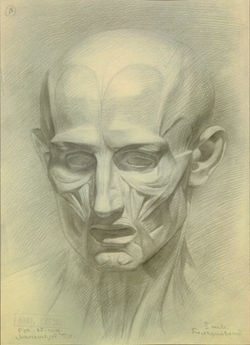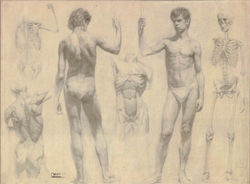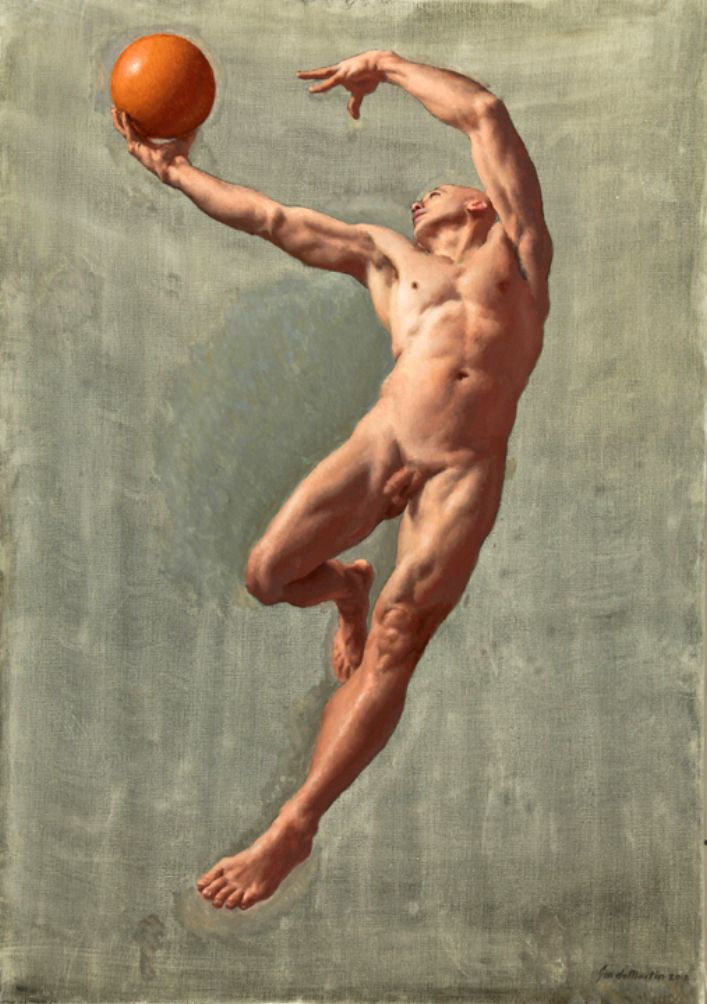
Guerra, who has been since his childhood interested in classical painting and the traditional methods of the craft, which gave painters of the past the ability to transform paint into three-dimensional images on flat surfaces, studied the academic methodology at The Florence Academy of Art. The FAA's curriculum, a modern adaptation of the Academic Philosophy, opened the doors for Guerra to explore the world of traditional materials and methods. These methods include some subjects not always obvious to someone not connected to Classical Art, such as Anatomy, the academic nude, grinding one's own paint, preparing one's own painting surface, color theory vs. pigments, and notions like chroma, hues and values.

 |  |  |
|---|---|---|
 |  |  |
 |  |
 |
|---|
 |
 |
 |
A good way for the artist to guarantee a good quality of the paint used on the artwork, and also have better control over it, considering the ratio between pigments and oil, is to make one's own paint, in a process called grinding the paint. Or, rather saying, grinding the pigment into paint. The pigment-oil ratio may affect the consistency of the paint, as well as the visual colour and how it mixes with other paints. Sometimes the readily bought tubes of paint contain binding agents, meant to avoid separation of the pigments from the oil or another medium, which may also affect the desired quality of the paint. For these reasons, the best way to control the consistency and colour strength of the paints, is to make your own.
Guerra uses good quality pigments, imported from different countries, including original Vermillion, Naples yellow, lead white and others, for many of his paints, .
Another way of ensuring the good quality of the material used in your artwork is to make and prepare your own canvases and panels. Although it is possible to find good quality of these materials on the market, Guerra sometimes prepares his own, stretching raw linen onto stretching bars, priming it with rabbit skin glue, laying a gesso ground and sealing it with an oil or varnish based imprimatura, after what the canvas will be ready to receive paint. In the same manner, some of the panels Guerra uses for plein air painting are also made by himself, with cut out wood and a ground of gesso or varnish.
 |
|---|
 |
 |
 |
 |
 |
 |
 |
 |
 |
 |
 |
 |
 |
 |
 |
 |
 |
 |
 |
 |
 |
 |
 |
Since the beginning of artistic representation, the represented human figure have aroused interest and admiration in observers, mainly due to the easy identification and correlation with the subject. Being one of the main subjects of Art throughout history, it is one of the fundamental topics in traditional art schools.
For classical and realistic artists, the knowledge of the human anatomy enables to represent the figure in a high degree of realism, with precision in its natural form, showing the beauty of the human being without abstractions or inventions that may end up overshadowing the true form and functions of the human body. Artists such as illustrators, painters and sculptors, study anatomy to understand the shape and structure of the human figure as they are in reality.
The Nude is used in the academic environment as a way to study and understand anatomy and human form, and it also contributes to the study of the values of light and shadow, as well as understanding the textures and colours of human skin.
For these reasons, in the Academies and Schools of Fine Arts, the living model is fundamental to the learning process, not only in the nude. Using the living figure, also in portraits and figurative works, the artist can study the physiognomic aspects in a clear and precise way, understanding the true anatomical structure more quickly and easily behind the different biotypes. Using live models, the artist can see in three dimensions what he studied in books through pictures and images, which allows him a better visualization and understanding of the anatomical structures.
From the knowledge acquired with studies of anatomy and the Nude, it becomes possible to represent the human figure with accuracy in more complex compositions. Examples below:














































































 |  |  |
|---|---|---|
 |  |  |
 |  |  |
 |  |  |
 |  |  |
 |  |  |
 |  |  |
 |  |  |
 |  |
If you wish to work from life, and maintain the correct sizes and proportions as seen in nature, the best method to use is the Sight-Size. As the name implies, it means to draw/paint/sculpt the same size as you see in real life. And it trains the eye to see, measure and compare, with great accuracy, lines, abstract shapes and values.
"The basic idea on which this method depends is setting up a specific relationship between you, the drawing, and the subject. The relationship necessary for the method to work is where you are positioned so that you can easily view the subject and drawing so they appear to be the same visual size. Once the subject and drawing are seen as being the same size, it becomes possible to mechanically measure and compare the proportions of the subject to the drawing and judge the drawing's accuracy. The process of engaging in this method, over time, trains the eye to perceive finer and finer deviations in form between the subject and drawing and increases the artist's ability to create realistic and accurate drawing."*
Depending on the subject, for example, still-life or portraiture, it would mean that the objects on the canvas are basically the same size as the real objects. If you are seeing something from a distance, as if you are painting a landscape, or wish to change the sizes of figures for a complex composition, it would mean that you would place yourself and the canvas far from the subjects to be painted, in order to change your perspective of the objects, and visually fit them on your canvas, being able to compare the sizes and apply on your canvas.
"In a studio setting, if you were drawing a model, the position of the model would be fixed, but your drawing and your position would be movable. To get the model to fit on your paper, as you moved away from the model, the model's visual size would become smaller. Plus, the distance between you and the easel can be varied to alter the size of the drawing corresponding to the model. As the easel is moved closer to the model, the size of the drawing would approach the actual size of the model."*
*Extracted from Ben Rathbone's blog.
If you wish to know more about the Sight-Size Method, you can visit Darren R. Rousar's website or read this article by the Swedish Academy of Realist Art, which contains many good pictures to better visualize the method.

 |
|---|
 |
 |
 |
 |
 |
 |
 |
 |
 |







